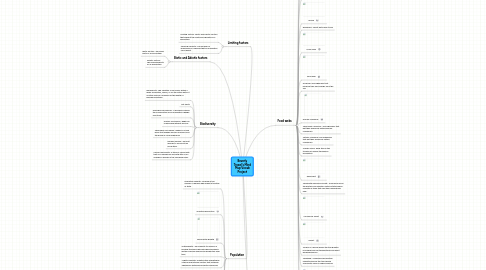Beverly Troxel's Mind Map Vocab Project
by Beverly Troxel

1. Biotic and Abiotic factors
1.1. Biotic factors- The living parts of an ecosystem.
1.2. Abiotic factors- The nonliving parts of an ecosystem.
2. Biodiversity
2.1. Biodiversity- The variation of life forms within a given ecosystem, biome, or for the entire Earth; it is often used as a measure of the health of biological systems.
2.2. Hot spots
2.3. Ecological succession- A process in which the communities of an ecosystem change over time.
2.4. Primary succession- Begins in a new place without any soil.
2.5. Secondary succession- Begins in a new place that already has soil and was once the home of living organisms.
2.6. Pioneer species- The first species to move into an ecosystem.
2.7. Climax community- A type of community that is in equilibrium and with little or no change in species in the following years.
3. Limiting factors
3.1. Limiting factors- Biotic and Abiotic factors that prevent the continuous growth of a population.
3.2. Carrying capacity- The number of individuals of a species that an ecosystem can support.
4. Population
4.1. Population growth- Increase in the number of people who inhabit a territory or state.
4.2. Industrial Revolution
4.3. Exponential growth
4.4. Sustainability- The capacity to endure; in ecology the word describes how biological systems remain diverse and productive over time.
4.5. Logistic growth- Growth rates regulated by internal and external factors that establish equilibrium with environmental resources.
4.6. J-curve
4.7. S-curve
4.8. Population growth rate- The change in population over time.
5. Food webs
5.1. Organism
5.2. Population
5.3. Community- All the speices who inhabit an area, region or country.
5.4. Ecosystem-Organisms and their enviroment.
5.5. Biome
5.6. Biosphere- Planet Earth and its life.
5.7. Food chain
5.8. Food web
5.9. Producer-The organisms that produce their own energy from the sun.
5.10. Primary consumer
5.11. Secondary consumer- The organisms that get their energy by eating primary consumers.
5.12. Tertiary consumer-The organisms that get their energy by eating consumers.
5.13. Trophic levels- Each step in the transfer of energy through an ecosystem.
5.14. Rainforest
5.15. Temperate deciduous forest- A biome found in the Eastern and Western United States which consists of trees that lose their leaves every year.
5.16. Coniferous forest
5.17. Desert
5.18. Tundra-Is a biome where the tree growth is hindered by low temperatures and short growing seasons.
5.19. Savannah- A grassland ecosystem characterized by the trees being sufficiently small or widely spaced.
5.20. Freshwater biome
5.21. Marine biome
6. Water pollution
6.1. Aquifer
6.2. Water pollution- Contamination of water, especially surface water, by sewage effluent, fertilizer runoff, industrial chemical discharge, etc.
6.3. Point source pollution- Pipes dumping toxic industrial waste into a river.
6.4. Non-point source pollution- A large amount of water pollution not coming from a single point but from many different sources.


